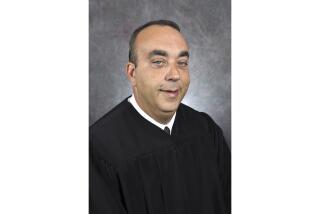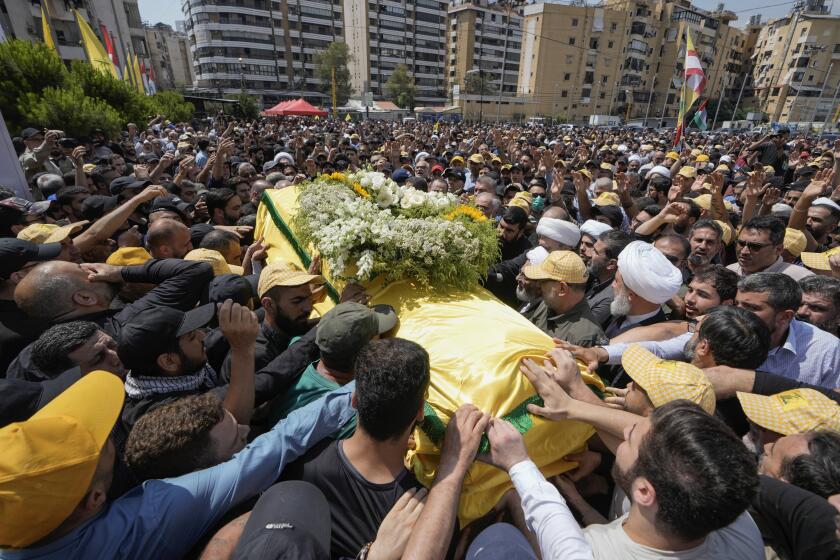Battles Take Daily Toll in Sadr City
The neighborhoods of Baghdad’s worst slum are draped in black. Scores of mourning banners bearing the names of those killed in recent weeks hang from fences, balconies and buildings along Sadr City’s dusty, garbage-strewn streets.
One banner laments a son killed “defending his country.” Some bear photographs of the dead. A few have two, three, even four names squeezed onto them.
For the record:
12:00 a.m. June 24, 2004 For The Record
Los Angeles Times Thursday June 24, 2004 Home Edition Main News Part A Page 2 National Desk 1 inches; 61 words Type of Material: Correction
Sadr City -- A June 7 article in Section A about the Baghdad neighborhood Sadr City said a U.S. helicopter fired into a crowd during an incident last summer. The article should have indicated that there were conflicting reports about where the shots came from. Witnesses said shots came from the helicopter, but U.S. military officials said ground troops opened fire.
As Iraqi and U.S. leaders focus on ending the bloodshed in the southern holy cities of Najaf, Kufa and Karbala, Baghdad’s backyard is quietly boiling over.
U.S. military officials estimate that they have killed more than 800 Iraqis in Sadr City over the past nine weeks -- more than a dozen a day -- in battles with the Al Mahdi army, the militia of radical Shiite Muslim cleric Muqtada Sadr. That’s more than twice the number hospitals estimate were killed in similar fighting in southern Iraq.
“It’s a daily massacre,” said Qassim Kadim, a native of Sadr City, also known as Thawra.
Most of the dead are young, unemployed men who joined Sadr’s militia and have orders to shoot U.S. forces on sight. Others are bystanders caught in the crossfire, such as a 14-year-old boy who was killed Sunday by a roadside bomb targeting a passing U.S. convoy.
Either way, residents say, they are the sons of this downtrodden Shiite community, and their deaths have touched nearly everyone.
There are no gold-domed mosques here, no historical sites to draw the world’s attention to their losses. As has been the case for decades, residents complain, the suffering in Sadr City -- a sprawling neighborhood of 2 million Iraqis who were severely oppressed by Saddam Hussein -- goes largely unnoticed.
“So many people are dying here, and no one cares,” said Mohammed Khala, 57, a video arcade owner whose apartment was recently riddled with bullets and shrapnel from U.S. tanks that attacked militiamen who had taken refuge behind his home. He broke his hand in the attack and his 5-year-old daughter suffered shrapnel wounds in the head, he said.
At least 14 U.S. soldiers have died in and near Sadr City since April. They include five killed Friday when their convoy was struck by a rocket-propelled grenade on the outskirts of the area and two killed Saturday by a roadside bomb at the same location.
The cycle of violence began two months ago, after Sadr’s militia seized control of mosques, government offices and police stations in several Shiite cities and neighborhoods, including Sadr City, which was renamed in tribute to Sadr’s father, a revered cleric who was assassinated during Hussein’s rule. Before then, it was known as Saddam City.
With few exceptions, street violence and gun battles have been a nightly ritual. Sadr forces regularly fire mortar rounds at U.S. bases and Iraqi police stations used by American soldiers. U.S. troops razed Sadr’s office last month, but his followers rebuilt it in a day. When residents emerge in the mornings, they confront a trail of burned cars, bullet shells and bodies.
“The other day I was walking home and found a man just lying in the street,” said Raad Mehemdawi, 32, a warehouse worker. “When I went to help him, I realized he was dead. I called his friends in the Mahdi army and they came and carried him away.”
After the war, Sadr City residents welcomed U.S. soldiers. “I want the Americans to stay because we owe them a big debt for liberating us from Saddam,” said Ahmed Waleed, 32, a restaurant owner who is still a supporter.
But over time, many have lost patience with lingering electricity outages and soldiers’ perceived lack of respect for the community’s religious leaders and symbols, along with the mounting deaths. Last summer, soldiers knocked a religious banner off a transmission tower, sparking a small riot that ended with a U.S. helicopter firing into a crowd. More recently, residents say, soldiers have taken to removing the ubiquitous pictures of Muqtada Sadr from billboards and fences.
“People are very resentful,” said Jalbar Braian, 45, a car salesman. “We just want the Americans to go away.”
Military officials say they sympathize with the plight of Sadr City residents and note that the slum’s problems predate the U.S.-led invasion. They say most residents support the American presence but are afraid to speak out for fear of retribution by the Al Mahdi army. About a month ago, a local councilman who was working with the U.S. was kidnapped and hanged from a power pole.
“If we just pulled out, the militia would take control, and 90% of the people here don’t want that to happen,” said Lt. Col. Gary Volesky, battalion commander of the Army’s 1st Cavalry Division in Sadr City. “The police can’t handle it.” He said the area has 500 Iraqi police officers but needs about 7,000.
In fact, police in the community are trying to avoid taking sides. One officer was demoted when he said he would refuse to fight the militia, according to Lt. Col. Raheem Qadir of the Nasr station.
U.S. soldiers occupied Qadir’s station for nearly a month until he asked them to leave because they were drawing attacks from the militia, damaging nearby homes, Qadir said. After the soldiers left, Al Mahdi fighters told him to remove the sandbags from his roof, used by U.S. snipers. He complied.
“I don’t see this as an army,” he said. “It’s an uprising against the occupation. Citizens of any country being occupied by another country would react in the same way.”
But on Sunday, 15 Al Mahdi army members attacked his police station again, setting off a small explosion that destroyed ammunition and a roomful of furniture. Unlike in southern Iraq, there are no truce talks or cease-fire negotiations in Sadr City, Qadir said.
But Volesky’s unit is stepping up efforts to win over residents with humanitarian projects, spending $1.1 million to fix the sewage system, which leaks into the streets. This weekend, his troops began distributing medical supplies worth several hundred thousand dollars to local pediatricians.
But such efforts are often overshadowed by street fighting and attacks. In one day last week, Sadr’s militiamen and U.S. troops engaged in 21 battles in the district. Volesky insists that the vast majority of those killed are Al Mahdi fighters, not civilians. “We are very precise,” he said.
The ragtag militia’s heavy losses reflect its youth and inexperience as well as the disparity in weaponry. Some members are in their teens. At times, even U.S. military officials express concern about the one-sidedness of the battles.
“As a soldier, it’s tough to go out and have to fight, and I can tell you it’s even tougher when you’ve got 17-year-old kids picking up [rocket-propelled grenades] and aiming them at you,” Brig. Gen. Mark Kimmitt, the top U.S. military spokesman, said in a recent briefing.
“It’s very tough to have to do your job at that time, and we don’t take any glory and we don’t take any pride in having to do it,” he said. “So, frankly, any time we have to kill one of those kids because he’s aiming a weapon at us, aiming an RPG at one of our soldiers, aiming a rifle at one of our tanks, it’s not a good day.”
A father of three Al Mahdi army fighters said he’s proud of his sons, who he believes are fighting, and fought, in self-defense. His youngest was killed after firing a machine gun at a U.S. helicopter, which shot back, he said. Another lay on the bare floor of their small Sadr City home, plastic tubes snaking out of his chest after he was shot in the same attack.
The father, who would give his name only as Abu Ali, asked: “Who is responsible for the killings of these innocent young men?”
Special correspondents Raheem Salman, Saif Rasheed and Caesar Ahmed contributed to this report.
More to Read
Sign up for Essential California
The most important California stories and recommendations in your inbox every morning.
You may occasionally receive promotional content from the Los Angeles Times.










